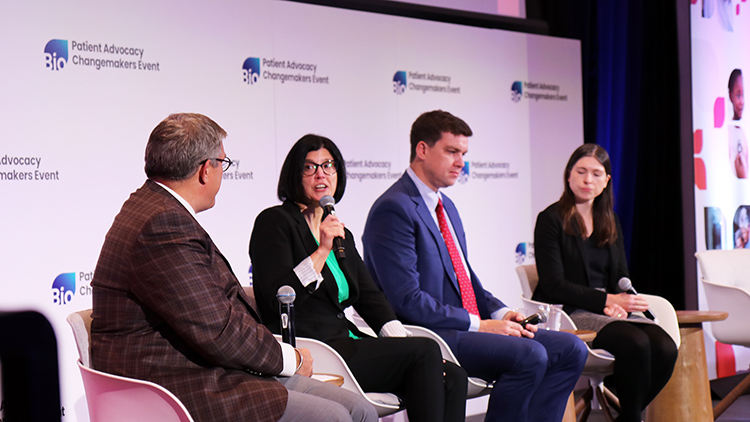With Medicaid cuts expected, vaccine hesitancy getting politicized, and the continued challenge of Prescription Drug Affordability Boards (PDABs), state legislatures will drive many of the policies impacting patients’ access to drugs in the coming months.
That’s why patients must be involved in advocacy on the state level, according to many of the speakers at the Biotechnology Innovation Organization (BIO) Patient Advocacy Changemakers Event (PACE) in Washington, D.C., from Oct. 26-28.
Achieving change in state legislatures is complex because each state handles the issues differently, according to Patrick Plues, BIO’s Senior VP, State Government Affairs & Affiliate Relations, who moderated the first of several panels on state policy.
Northe Saunders, President of American Families for Vaccines, agreed.
“We have 50 different states, 50 different political environments, 50 different regulatory environments, 50 different ways that a bill gets introduced and moves through the legislature,” Saunders said. “And so there are 50 different strategies that we’re going to have to employ to respond to what’s happening.”
While they may handle things differently, states do learn from one another when designing policies, Brian Warren, BIO VP of State Government Affairs, told the gathering.
“States will follow each other’s lead. It’s interesting to see experience shared from one state to the other,” he said. Patient advocates can help inform this learning process.
Interview with Brian Warren, VP of State Government Affairs at the Biotechnology Innovation Organization (BIO), at PACE 2025
The importance of the patient voice
When it comes to addressing the diverse policies of the states, inserting the patient voice is essential, and involving patients is an effective strategy, panelists in various sessions agreed.
“We have been trying really hard to not only be out there representing the life sciences ecosystem itself, but also all of the patients that our members serve,” said Amy Goodman, VP and Counsel, Policy + Advocacy, Colorado BioScience Association. “We try to be partners and also elevate your voices in other ways, as well.”
A session on successes in state-level patient advocacy highlighted that more patients are joining the conversation.
“Getting patients to engage is a huge win, because that is our biggest challenge right now – not just getting them to engage, but getting the patient voice heard,” said Mark Hobraczk, Public Policy Director, AiArthritis.
Lawmakers are more ready to listen to patients on issues like Medicaid cuts, noted Hannah Green, Assistant Vice President, Nationwide Policy, American Lung Association. “The patients were really the ones who could open the door and have those conversations about what these cuts meant for them and their families and their communities,” she said.
The threats to Medicaid
Given plans for deep cuts in spending on the federal level, it seems clear that all states will have to find ways to reduce Medicaid budgets. What is not clear is how those cuts will be achieved, and that is causing a lot of concern in the patient community, said Green.
“The cost sharing, the exemptions for work requirements, they’re going to be different from state to state,” posing challenges for a nationwide organization, she explained. “We also must make sure that patients know they have an opportunity right now to shape what these cuts look like in their state.”
To impact Medicaid cuts, it will be important for patient advocates to recruit more patients who can speak to lawmakers, Green continued.
“Patient stories are going to be at the center of that work – looking to find patients who have been harmed by these cuts, to share their stories with policymakers, share them with the media,” she explained.
Medicaid cuts spark specific concerns for the rare disease patient community, said Kari Lato, Director of Policy & Advocacy, Rx4good, and founder of the Rare & Ready Coalition, which includes more than 100 rare disease advocacy groups. Families of rare disease patients often rely on special waiver programs to help them afford home care, “so the mom can go work and there’s a nurse at home taking care of the child who’s living with a rare disease. We’re really concerned about it, and that’s really a big priority for us next year.”
Patients finally being heard on PDABs
Along with Medicaid cuts, PDABs – state boards that seek to cap prices for prescription drugs – were another major concern for everyone at the conference. (PDABs also came up at a recent BIO Coffee Chat.) These boards have been widely criticized for harming innovation in medicines and limiting states’ access to prescription drugs. Yet several states have passed PDAB legislation, Colorado has begun using its PDAB to set prices, and other states are considering establishing them.
“At BIO, we’re looking right now at about 10 states where we could potentially see legislation introduced next year on these,” said Plues.
Lato founded the Rare & Ready Coalition in 2022 with the priority of dealing with PDABs, because “we found some really negative consequences of these PDABs when it comes to the rare disease community.”
“PDABs are really just bureaucratic panels that have insurers, pharmacists, state officials, and health economists on it—and no patients,” Lato said. “PDABs do not lower copayments. They do not reduce premiums. So far, of the four PDABs that already exist right now, they’ve spent over $15 million in taxpayer money, and patients have not seen a dime of savings.”
Fortunately, states are beginning to listen to patients and patient advocates.
“In the most recent Colorado PDAB meetings, although they set an upper payment limit for the first time, without going through a rigorous process that we think at a fair minimum really needed to take place, we were heartened at least a little bit to see that several PDAB members were acknowledging issues, finally, that patients and other stakeholders have been raising for a long time about unintended consequences,” said Goodman.
Hobraczk noted similar progress in other states.
“We have also seen an acknowledgement that patient input hasn’t been meaningful, and that they are looking for ways to finally address that. So whether it’s Colorado or Maryland or some of these other PDABs, there has been an acknowledgement of that.”
Vaccine legislation
Another priority policy area that BIO and patient advocates are watching is vaccines.
One Oct. 27 panel focused on patient advocacy’s impact on vaccine policy, particularly at the federal level. But as Plues noted, there is a lot of vaccine action at the state level.
“This year, we were tracking close to 400-plus pieces of legislation that have some vaccine component,” Plues said.
Saunders said American Families for Vaccines is looking to work with moderate Republicans on this issue. “They generally have been very supportive of strong vaccine policy for a long time,” he said.
While anti-vaccine voices may be the loudest, the majority of Americans are in favor of vaccines, and vaccine-hesitant attitudes are making it more confusing and difficult for people who want vaccines to get them, according to Saunders. Rather than trying to convert the vaccine-hesitant minority, advocates should demand that lawmakers ensure the vaccine access that the majority wants.
It’s not only pro-vaccine groups treating access as an issue, said BIO’s Warren. “It’s patient groups like the American Cancer Society and many other groups, like the Immune Deficiency Foundation, that are saying, ‘We’re patients too. We want vaccines.’ ”
Some victories
While there was a lot of talk about pushing back against troubling state legislation, there was also celebration of victories.
For example, there’s been a lot of legislation to require that insurers cover biomarker testing, according to Hilary Gee Goeckner, Director, State & Local Campaigns, Access to Care, American Cancer Society Cancer Action Network.
“Biomarker testing is used to match patients with the right treatment at the right time,” she explained. “Oncology has really led the way in biomarker-driven treatments. But there are current applications in other disease areas as well.”
Gee Goeckner described rapid success in this area, which is relatively new.
“We’ve worked in a really broad coalition to advance state legislation, aligning insurance coverage of biomarker testing with the latest evidence across disease types and stages,” she said. “In just the last three or four sessions, 22 states have enacted laws that are consistent with the model legislation we’ve developed in partnership with patient and provider organizations.”
Other positive developments include effective use of technology. Hobraczk of AiArthritis noted the advantages of easier communication, like patients being able to talk with one another in real-time during a PDAB hearing. “That’s really changed how we can engage patients, because now they can share stories as they’re commenting,” he said.
Virtual meetings have made it easier for patients to talk to lawmakers.
“I think it’s incredible because you have so many patients who want to get involved, but they may have mobility concerns,” BIO’s Warren said. “This gives people the ability to engage.”




